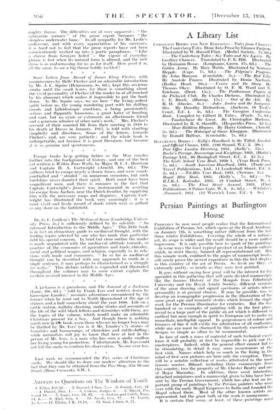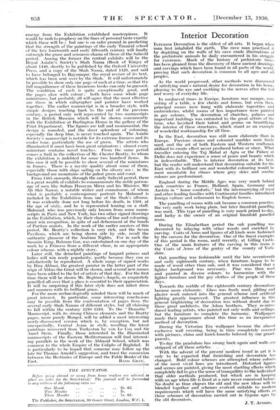Persian Paintings at Burlington House
Prionnimy by now most people realize that the Internationd Exhibition of Persian Art, which opens at the Royal Academy on January 7th, is something rather different front the lash three winter Exhibitions. Covering the whole of a nation's art. its scope is wider and the result should be a more impression. 'It is only possible here to speak of the painting. some ways the least typical product of an Islamic culture which, in strict theory, banned all representational art. But this minute work, confined to the pages of manuscript books. will surely prove the newest experience in this the first display in this country of the art of Persia. So fresh are they. s■ extremely pretty, so nearly as they were first painted.
It goes without saying how great will be the interest for the specialist in this gathering that will unite divided manuscripts like the famous History of the Mongols from Edinburgh University and the Royal Asiatic Society, different versions Of the sante drawing and signed specimens of artists whose personality is at present elusive. It may be possible, too, to develop an iconographic progression in the illustraf of the same great epic and romantic stories which, formed the staple work for the Persian illuminator for centuries. But the live hundred or so examples of painting will, in the first place. reveal to a large part of the public an art which is different ill method but near enough in spirit to European art to make an diate, intelligible appeal. In gorgeousness of colour and iiTIIII1CSS of line it will excite the admiration of all craftsmen. while any eye „t be charmed by this masterly execution of designs so simple as often to be momunental.
In face of such a mass of material of such technical excel- lence it will probably at first be impossible to pick out the masterpieces. Indeed, while the general effect cannot fail to be stimulating, in detail it may seem monotonous at the first visit. Names which help so much in the fixing in the mind of first seen pictures arc here only the exception. Therc will be a notable collection of works attributed to the most famous master, Bihzad. including three manuscripts front this country, two the property of Mr. Chester Beatty and one of. Major Macaulay. In addition, three most interesting detached miniatures and a manuscript given to him have been sent by the Persian Government, which has also lent an im- portant group of paintings by the Persian painters 1010 went over with the early Mogul Emperors to India and founded tlw Mogul school there. Most of the other known artists are represented. but the great bulk of the work is anonymous. It is certain that some, at least. of these. paintings must
emerge from the Exhibition established masterpieces. It would be rash to prophesy on the lines of personal taste exactly which these will be - but one is on safer ground in predicting that the strength of the paintings of the early Timurid school of the late fourteenth and early fifteenth century will finally outweigh the grace and sensuous charm of those of the Safavid period. Among the former the central exhibits will be the Royal Asiatic's Society's Shah Noma (Book of Kings) of about 1440, shortly to be puhlished by the Oxford University Press, and a copy of the Shah Kama, dated 1429, and said to have belonged to Baysunqur, the royal reviser of its text, which has been sent over by the Shah. It will unfortunately be possible to show only one page of each at a time, so that the full magnificence of these luxurious books can only be guessed. The condition of each is quite exceptionally good, and the pages glow with colour : both have some whole page miniatures, but probably all will agree that the most effective are those in which caligrapher and painter have worked together. The earlier manuscript is in a broader style, with simple designs reaching back to the end of the previous century, a period only well represented by two manuscripts in the British Museum which will be shown concurrently with the Exhibition at Burlington House in the gallery of the Print Department. The figures are tall and monumental, the design is rounded, and the sheer splendour of colouring, especially the deep blue, is never touched again. The Asiatic Society's manuscript is notable for its extreme fineness and its cooler tone, particularly the use of green. The artists who illuminated it must have been great originators : almost every miniature contains novel touches. From the same period comes a Sadi in the collection of Mr. Chester Beatty, to whom the exhibition is indebted for some two hundred items. In this case it will be possible to show several of the miniatures in frames. There is a mystic quality about some of them, especially those with ships sailing on the silvery sea : in the background are mountains of the palest green and coral.
From 1485 onwards, through the early Safavid period, there is a great wealth of exhibits to commemorate the noble patron- age of men like Sultan Husayan Mirza and his Minister, Mir All Shir Nawai, a notable writer and connoisseur, of whom what is probably a contemporary portrait by Mahmud is included in the Exhibition from one of the Shah's albums. It was evidently done not long before his death, in 1501, at the age of sixty, :Ind he is represented leaning on a staff. Mahmud, who was previously only known from some manu- scripts in Paris and New York, has two other signed drawings in the Exhibition, which, by their charm of line and colouring, must win recognition, in spite of sad defacement at the hands of Puritan zealots. In the work of the earlier masters of this period, Mr. Beatty's collection is very rich, and the Seven Pavilions, which are being shown side by side, recall the authentic glamour or the Arabian Nights. For in each the Sasanin King, Bahram Gur, was entertained on one day of the week by a Princess from a different clime, in an appropriate colour scheme, with a nightly story.
Later still, the detached paintings of languid princes and ladies will win ready popularity, partly because they can so satisfactorily be reproduced. A whole range of signed works by Riza Abbasi, the greatest painter in the latter part of the reign of Abbas the Great will be shown, and several new names have been added to the list of artists of that day. For the first time there will be shown Mr. Beghian's Angels, so exquisitely pencilled all over that a glass is essential to their appreciation. It will be surprising if this later style does not infect dress and manners with its brilliant grace.
For the more archaeologically minded there will be much of great interest. In particular, some interesting conclusions may be possible from the confrontation of pages from the several early Shah Names of different styles, but all claiming to fall within the century 7210-1310. To the " Demotte " Manuscript, with its strong Chinese elements and the Beatty pages, more purely Mongol, will be added a most interesting newly-discovered version which is, by exception, but not unexpectedly, Central Asian in style, recalling the latest paintings recovered from Turkestan by von Le Coq and Sir Aurel Stein. Finally, those interested in the illuminated manuscripts of the Eastern Mediterranean will find interest- ing parallels in the work of the Abbasid School, which was common to the whole Empire of the Caliphs of Baghdad. It is particularly to be hoped that someone may follow up the late Sir Thomas Arnold's suggestion; and tram the connexion between the Bestiaries of Europe and the Fable Books' of the















































 Previous page
Previous page